Introduction
In a rapidly evolving business landscape, organizations are increasingly turning to Centers of Excellence (CoEs) as a strategic response to enhance operational efficiency and drive innovation. CoEs serve as specialized hubs that foster expertise, streamline processes, and promote best practices across various domains, from technology to human resources. By focusing on specific challenges such as manual workflows and staffing shortages, these centers not only optimize performance but also empower teams to leverage advanced solutions like Robotic Process Automation (RPA).
As companies navigate the complexities of modern operations, understanding the purpose and implementation strategies of CoEs becomes essential for achieving measurable improvements and sustained competitive advantages.
This article delves into the significance of CoEs, exploring their diverse types, value propositions, and the strategies necessary for successful implementation and evolution.
Defining the Center of Excellence: Purpose and Importance
The coe team meaning refers to a Center of Excellence (CoE) that represents a specialized team or entity within a business, dedicated to fostering expertise, best practices, and innovation in a particular domain. The essence of a CoE team meaning lies in its ability to provide strategic leadership and facilitate knowledge sharing, ensuring that best practices are not merely theoretical but actively implemented across the organization. As Margaret Wilhelm, Vice President of Customer Insights at Fandango, aptly noted,
We’re so much closer to the customer now.
And that’s made our whole company better.
This sentiment reflects the transformative potential of coe team meaning, especially in enhancing operational efficiency and driving innovation. A notable example is the COVID-19 Center of Excellence at UTHealth, which was established to focus on research and response to the pandemic, illustrating how such centers can effectively manage crises and improve organizational responses.
By creating a clear roadmap and strategy, organizations can leverage the capabilities of the coe team meaning to address specific challenges—whether in robotic process automation (RPA) or analytics. Recent developments highlight that the coe team meaning is increasingly crucial in optimizing operations and elevating organizational performance. For instance, a mid-sized company faced significant challenges with manual information entry errors and slow software testing processes, which hindered their operational efficiency.
By implementing GUI automation, they achieved a 70% reduction in data entry errors and a 50% acceleration in software testing processes—key metrics that demonstrate the effectiveness of centers of excellence in driving operational efficiency. Furthermore, RPA solutions like EMMA RPA, which automates repetitive tasks and enhances workflow efficiency, and Microsoft Power Automate, which streamlines processes and provides risk-free ROI assessments, have been instrumental in improving employee morale and productivity. In 2024, studies suggest that the coe team meaning is reflected in the enhancements experienced by entities with Centers of Excellence, achieving up to 30% improvements in key performance metrics.
For leaders aiming to enhance their operations, understanding and implementing the CodE model is not just beneficial; it is essential for achieving measurable improvements in efficiency and effectiveness.
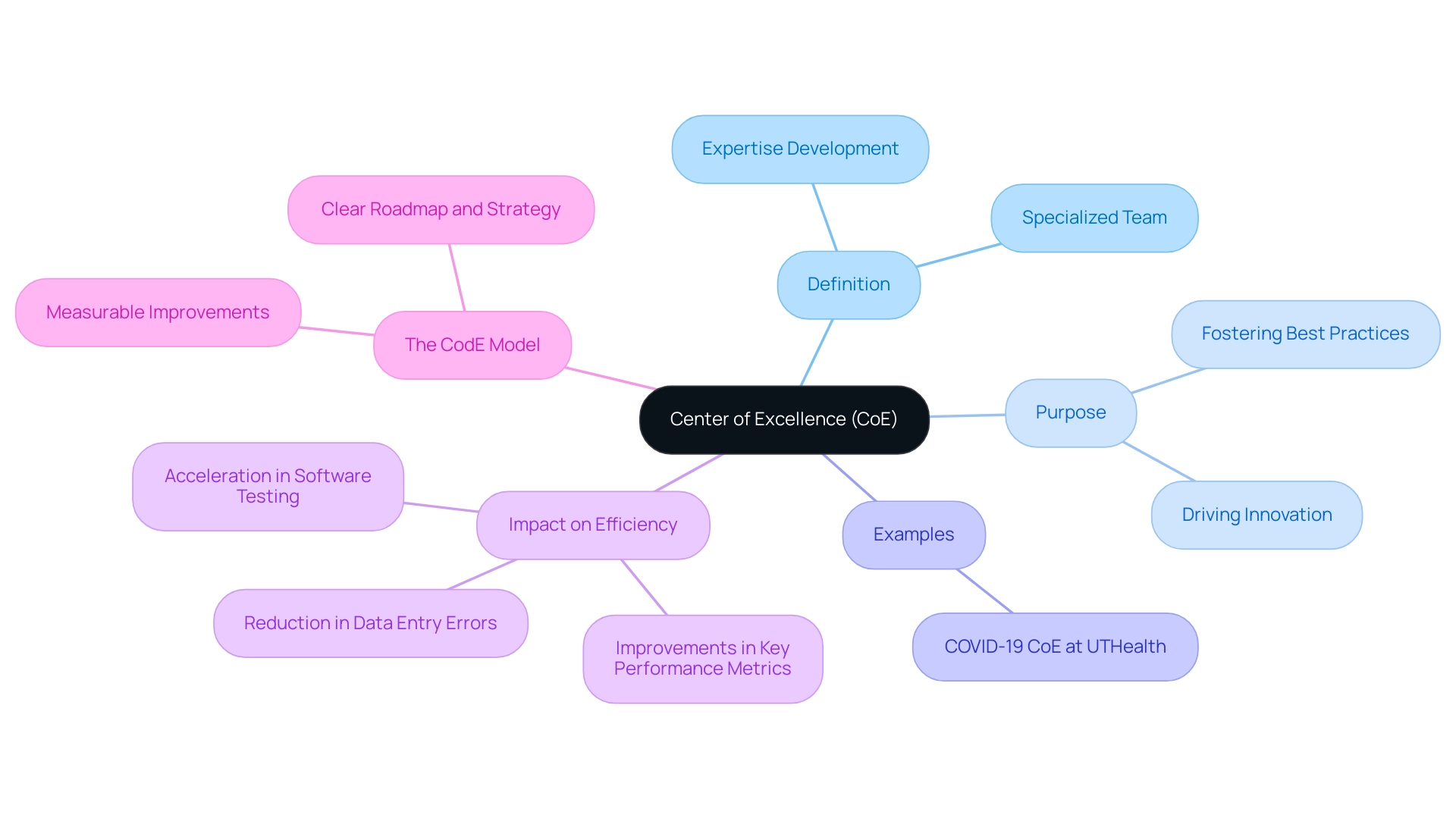
Exploring Different Types of Centers of Excellence
Organizations can leverage various types of Centers of Excellence to enhance their operational effectiveness amid challenges like repetitive tasks, staffing shortages, and outdated systems. Functional centers of excellence concentrate on specific business functions such as:
- Human Resources
- Information Technology
- Finance
This allows organizations to hone in on specialized expertise. Technological centers of excellence focus on harnessing innovations like:
- Artificial Intelligence
- Internet of Things
- Robotic Process Automation (RPA)
These innovations drive efficiency and combat the burden of manual workflows.
For instance, UserTesting’s enhancement of customers’ search experience has led to higher conversions and improved bottom-line revenue, illustrating the tangible advantages of implementing centers of excellence effectively. Moreover, RPA solutions play a vital role in modernizing operations by automating repetitive tasks, thereby enhancing productivity and reducing errors. Process-focused centers of excellence aim to refine workflows, which is crucial for addressing specific challenges within an entity’s processes.
Each type of CoE reflects the coe team meaning, serving unique purposes tailored to meet the distinct needs and challenges faced by an organization, thereby enhancing productivity. Additional types of centers of excellence, such as those focused on:
- Supply chain
- Quality assurance
- Digital transformation
These further illustrate the diverse applications of these entities across various sectors. Insights from case studies, such as the strategies detailed in ‘Three Ways to Make Your Information Do More,’ highlight the significance of implementing AI and minimizing complexity to enhance business outcomes.
By understanding these options, leaders can implement centers of excellence that not only align with their strategic objectives but also significantly enhance overall performance. Furthermore, the integration of Business Intelligence (BI) is crucial, as it transforms raw data into actionable insights, enabling informed decision-making that drives growth and innovation. As Margaret Wilhelm, Vice President of Customer Insights at Fandango, aptly states,
We’re so much closer to the customer now.
And that’s made our whole company better.
This sentiment highlights the transformative potential of well-structured centers of excellence in fostering collaboration, innovation, and ultimately, improved business outcomes.
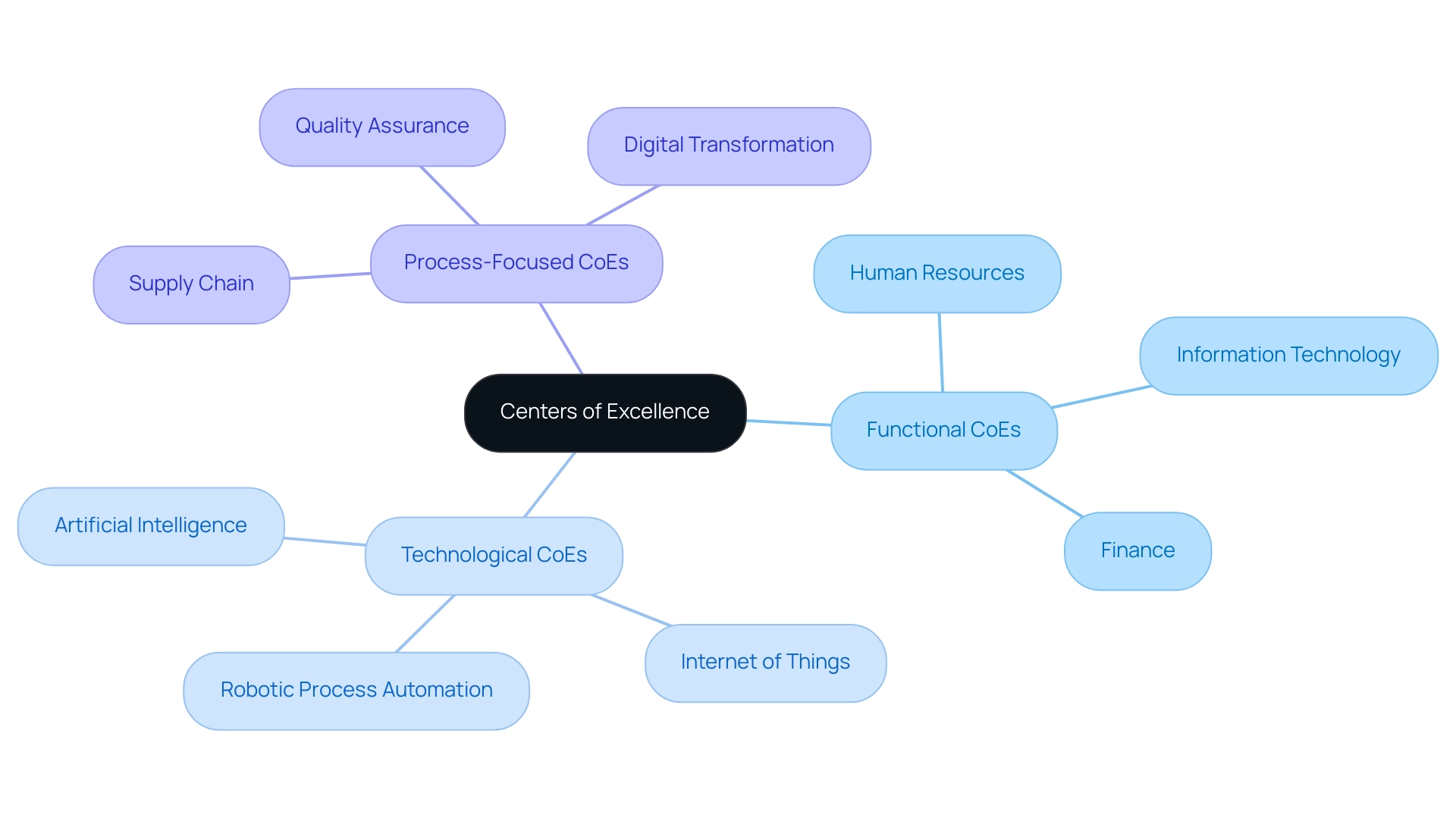
The Value Proposition of Centers of Excellence
The coe team meaning serves a crucial function in entities by fostering a culture of ongoing enhancement and promoting innovation. They serve as hubs for specialized knowledge, streamlining processes and enhancing decision-making capabilities, particularly in leveraging Robotic Process Automation (RPA) to automate manual workflows. By centralizing expertise in information management and analytics, Codes empower organizations to keep pace with the rapidly evolving AI landscape, ultimately fostering a competitive advantage.
Investing in a Code is not merely an operational decision; it is a strategic move that can lead to substantial long-term benefits. An effective CoE requires a skilled team of information professionals and RPA specialists, which highlights the coe team meaning, necessitating an investment in talent and training. This diverse ACE team should include individuals proficient in:
– Data analysis
– Data engineering
– Business analysis
– RPA governance
As noted by the Chief Data Officer,
Ultimately, the CDO’s leadership and strategic positioning are critical to harnessing the full potential of the CoE, driving innovation, and achieving sustainable competitive advantages.
Furthermore, entities must establish clear metrics to measure the impact of their CoE initiatives. For instance, defining metrics enables entities to evaluate the value and effectiveness of the ACE over time, such as tracking the number of data-driven initiatives, employee training in analytics, and the implementation of RPA solutions.
These metrics can include:
– Reductions in operational errors
– Time saved on manual tasks
– Improvements in team resource allocation towards strategic projects
These benefits include significant cost savings, improved employee engagement, and heightened customer satisfaction, thus reinforcing the value proposition of centers of excellence in driving organizational performance well into 2024 and beyond. Additionally, addressing the challenges posed by manual, repetitive tasks is crucial, as these can hinder efficiency and lead to wasted resources, making the case for RPA even stronger.
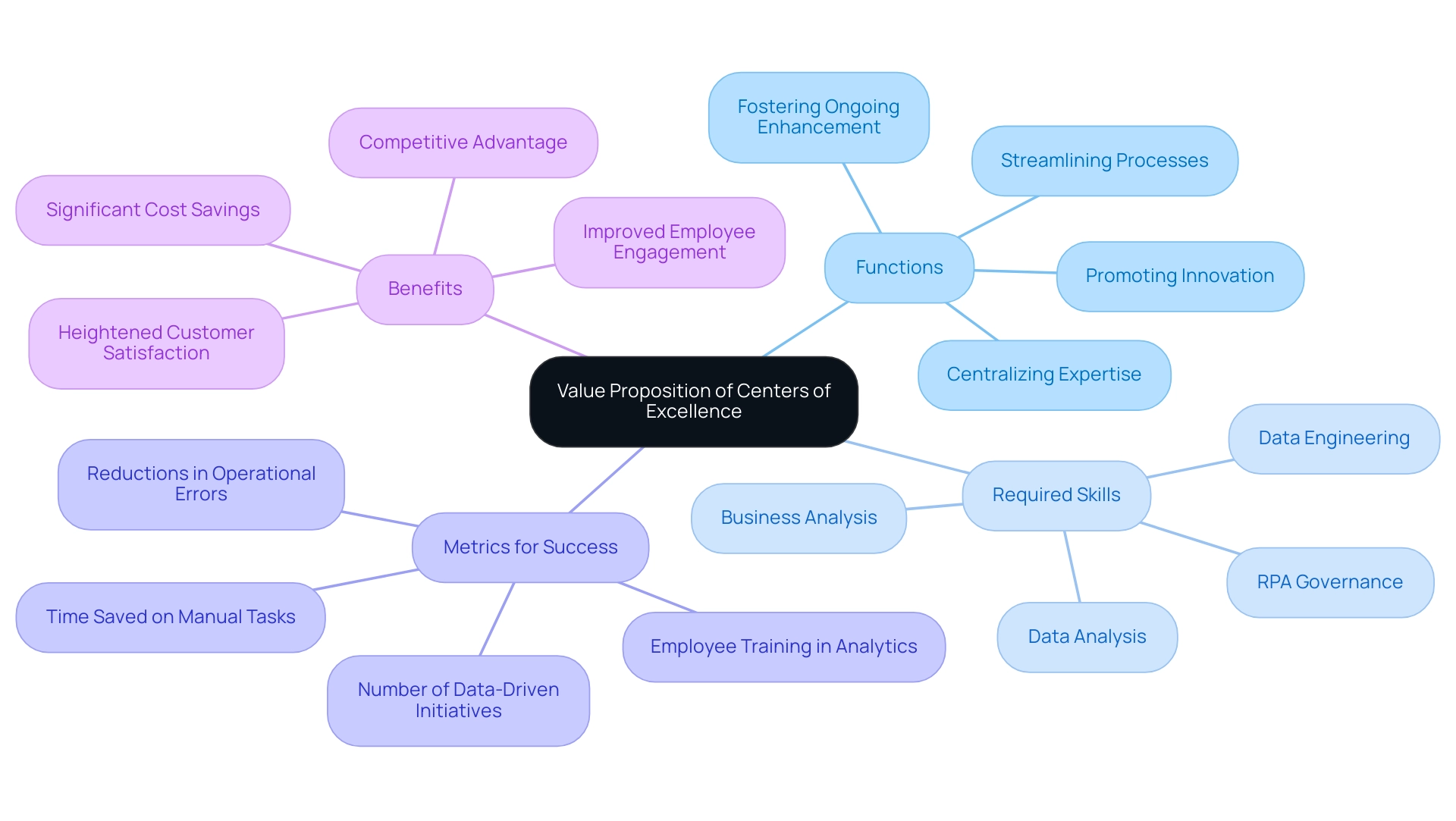
Implementing a Center of Excellence: Strategies for Success
Successfully implementing a Center of Excellence (CoE) requires understanding the coe team meaning, which begins with defining clear objectives that resonate with organizational goals. It’s crucial to identify and engage the right stakeholders early in the process, securing executive sponsorship to ensure top management support. A recent observation from corporate experts highlighted a list of 100 areas needing improvement after site visits, underscoring the necessity of a structured approach to address specific challenges in Code implementation.
Manual, repetitive tasks can significantly slow down your operations, leading to wasted time and resources; integrating Robotic Process Automation (RPA) can significantly streamline workflows, enhancing operational efficiency and allowing your team to focus on more strategic initiatives. Establishing a robust governance framework is essential; it should clearly define roles, responsibilities, and decision-making processes to foster accountability and transparency, especially in light of new SEC ESG regulations that may influence compliance requirements. The rapidly evolving AI landscape can be daunting, making it essential to tailor AI solutions to your unique business context, ensuring that you adopt the right tools that align with your goals.
Investing in training and resources is equally important, as understanding the CoE team meaning equips members with the necessary skills to drive initiatives effectively. Regularly tracking progress and soliciting feedback not only facilitates continuous improvement but also enhances stakeholder engagement—a critical component for success. According to a report by the Data Governance Institute, entities with a coe team meaning enjoy improved information quality and compliance, with 80% of them having strong governance frameworks compared to just 45% lacking.
The College of New Jersey’s Center for Excellence in Teaching and Learning (CETL) exemplifies this structured approach, as it plans to expand its online resources and strengthen connections with schools over the next two years by focusing on tailored solutions for faculty development. By adopting these strategies and utilizing Business Intelligence to convert information into actionable insights, entities can ensure their codes provide significant value.
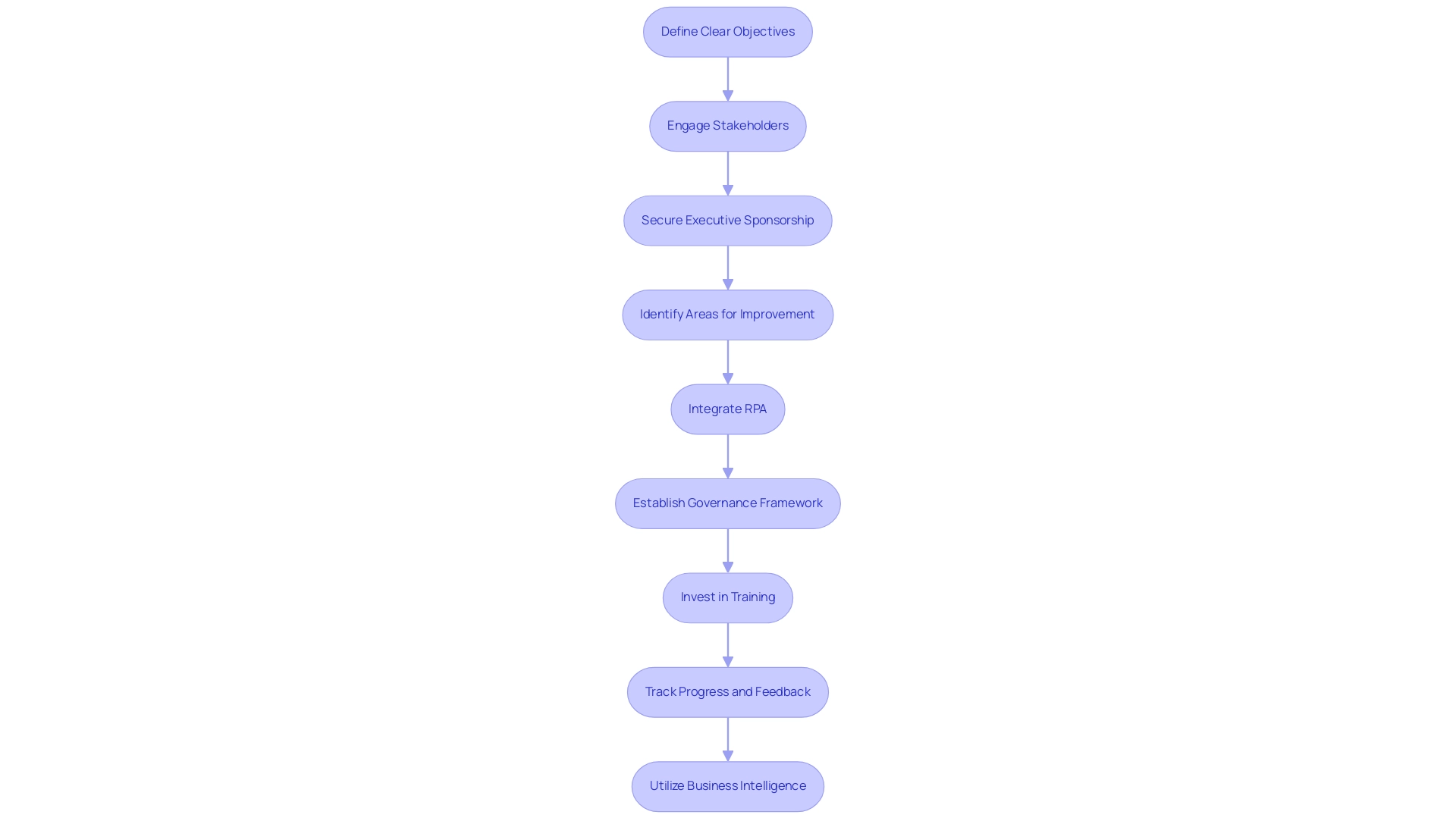
Sustaining and Evolving Your Center of Excellence
To effectively sustain and evolve a Center of Excellence (CoE), leaders must proactively assess the coe team meaning and its relevance amidst the ever-changing organizational landscape and market dynamics. By leveraging Robotic Process Automation (RPA), companies can automate repetitive manual workflows, significantly enhancing operational efficiency, reducing errors, and freeing up team capacity for more strategic, value-adding work. Establishing clear metrics is essential for evaluating the coe team meaning, which enables the collection of valuable insights from both internal and external stakeholders.
For instance, metrics such as the following can provide concrete measures of the CoE’s effectiveness:
- The number of evidence-based decisions made
- The level of information literacy among employees
- The speed of information processing
Fostering a culture of innovation within the CoE is crucial; understanding the coe team meaning can be achieved by promoting experimentation and collaboration among team members. Additionally, navigating the rapidly evolving AI landscape is vital—tailored AI solutions can help identify the right technologies that align with specific business goals.
Staying informed about the latest industry trends and emerging technologies, such as artificial intelligence and machine learning, will ensure that the Code remains a leader in best practices. Statistics indicate that 80% of entities with a Code have strong governance frameworks in place, a stark contrast to the 45% of those lacking one. This highlights the meaning of the coe team in enhancing efficiency and driving strategic decision-making.
The primary purpose of a Data and Analytics CoE is to centralize expertise and resources in data management and analytics, which reflects the coe team meaning by fostering a data-driven culture that supports strategic decision-making throughout the entity. Ultimately, as the Chief Data Officer aptly notes,
Ultimately, the CDO’s leadership and strategic positioning are critical to harnessing the full potential of the CoE, driving innovation, and achieving sustainable competitive advantages.
By fostering an adaptive Code that incorporates RPA and Business Intelligence, entities can continue to leverage its expertise and insights, leading to sustained improvements in operational efficiency and innovation.
We encourage you to explore RPA solutions to unlock these benefits and drive your organization’s success.
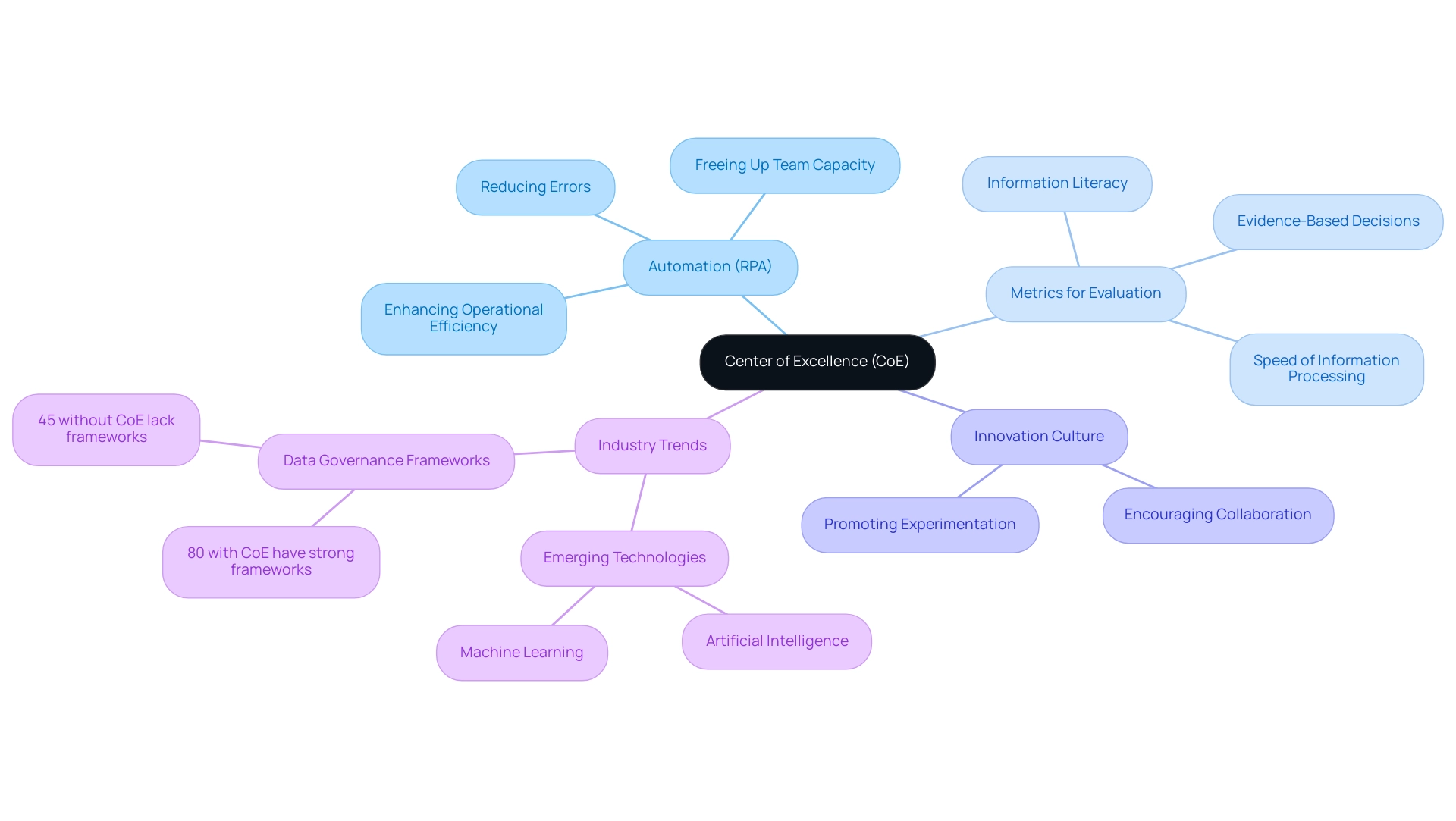
Conclusion
In the current business environment, the establishment of Centers of Excellence (CoEs) has emerged as a vital strategy for organizations seeking to enhance operational efficiency and foster innovation. By concentrating expertise in specific domains, CoEs not only facilitate knowledge sharing but also drive the implementation of best practices that lead to measurable improvements in performance. The diverse types of CoEs—from functional and technological to process-focused—provide tailored solutions to unique organizational challenges, enabling companies to optimize workflows and leverage advanced technologies such as Robotic Process Automation (RPA).
The value proposition of CoEs is clear: they cultivate a culture of continuous improvement and empower organizations to navigate the complexities of modern operations. By investing in skilled teams and establishing clear metrics, organizations can track the impact of their CoE initiatives, ensuring alignment with strategic objectives. The integration of RPA and Business Intelligence further enhances decision-making capabilities, transforming raw data into actionable insights that drive growth.
To sustain and evolve a CoE, it is crucial for leaders to regularly assess its relevance and effectiveness in light of shifting market dynamics. By fostering a culture of innovation and embracing tailored AI solutions, organizations can ensure their CoEs remain at the forefront of industry best practices. The leadership and strategic positioning of the CoE are pivotal in harnessing its full potential, ultimately leading to sustained competitive advantages and improved operational outcomes. By embracing these strategies, organizations can unlock the transformative benefits of CoEs and position themselves for long-term success in an ever-evolving landscape.

